I love trains. Take a metro system, and you’ll be whisked to other parts of a city much faster than if you drive a car. Hop aboard an intercity train. In many cases, you’ll get to your destination reasonably fast. Taking the train induces less stress (as opposed to flying where you need to arrive at the airport hours in advance for multiple security checks), allows us to enjoy the scenery (instead of focusing on the road ahead when driving), and most importantly, helps reduce traffic congestion as trains carry more passengers than any other means of land transportation – in other words, they’re very eco-friendly.
Modern trains and railways were first introduced in Britain in the early 19th century during the Industrial Revolution. They played a crucial role in the rapid economic growth of the nation as they were often faster and more efficient in carrying people and goods from one place to another than horse-drawn carriages and water transportation. This technology was soon adopted by other European powers who not only implemented it on home soil, but also in their colonies across the globe.
Indonesia, or the Dutch East Indies as it was called back then, was among the first places outside Europe to have railways. First laid in the second half of the 19th century, what began as a rail line connecting the port city of Semarang to the interior of Java – allowing cash crops to be easily transported from Dutch-owned plantations to the port where they would then be shipped overseas – expanded rapidly in the subsequent decades. By 1928, a railway network totaling 7,464 kilometers was already in place throughout Java, Madura, Sumatra, and Sulawesi (the Dutch never built railways on the other islands).
While Semarang witnessed the first ever trains rolled out in the Dutch East Indies, eventually it was Batavia – the center of administration and economic hub of the Dutch colony – that had the busiest rail traffic not only on Java, but also in the entire archipelago. In 1870, the Nederlandsch-Indische Spoorweg Maatschappij (NIS), a private company headquartered in Semarang, built a railway line connecting Batavia and Buitenzorg (now Bogor) to the south with its terminus at Batavia Noord station. In 1887, another company called the Bataviasche Oosterspoorweg Maatschappij (known as BOS), operated a 56-kilometer railroad that went from the newly-constructed Batavia Zuid station to the east. Both the Noord (North) and Zuid (South) stations were in fact separated by just a few hundred meters in an area that is now part of Jakarta’s Kota Tua (the old town district).
In the late 19th century, the Staatsspoorwegen (SS), a railway company owned by the Dutch East Indies government, acquired Batavia Zuid station from BOS, as well as Batavia Noord from NIS fifteen years later. These happened in a period of time when the Dutch colonial government was carrying out a major infrastructure project to build a new deepwater harbor to replace Sunda Kalapa, Batavia’s old port which was increasingly becoming less competitive than Singapore – at that time still a British colony. Back then, only smaller boats could dock at the former, while larger ships had to anchor at a distance from the coast. This made exporting goods costly, for items had to be loaded to the smaller boats first, which would then carry them to the ocean-bound large vessels. This forced many to bypass Sunda Kalapa altogether and go straight to Singapore whose harbor was able to handle big ships.
Following its completion, Tanjung Priok – the new port – saw an increase in trade and shipping activities. This prompted the development of supporting facilities nearby, including a new train station to replace an existing one connecting the port with the city center. Construction began in 1914, and eleven years later the new Tanjung Priok station commenced operations. A year afterward, Batavia Zuid was demolished to make way for a new station, christened Batavia Stad, which was opened in 1929. Since then, all rail journeys to the city ended at this station, deeming Batavia Noord obsolete which resulted in its eventual demolition.
Today, Jakarta Kota (formerly Batavia Stad) station remains as busy as ever, serving as a terminus for key routes to some of Jakarta’s satellite cities. However, the situation at Tanjung Priok station is completely the opposite.
Back in the days when ocean voyages were the fastest way for people from Europe to travel to Asia – helped by the opening of the Suez Canal – some who arrived in Tanjung Priok opted to stay at the station before continuing their journeys onward by train to different parts of Java, and vice versa. This was made possible due to the presence of lodgings within the station’s premises. Tanjung Priok was also where the Dutch East Indies had its first ever electrified rail tracks, which are now used for all commuter trains serving the Greater Jakarta area.
Unfortunately, as air travel became faster and more affordable over the years, and the highway network expanded on the island, Tanjung Priok station gradually lost its appeal. In 1999, KAI (the state-owned railway company) even decided to end all passenger services from the station. 10 years later, Tanjung Priok was finally reopened, although the commuter line connecting this station and Jakarta Kota was only reactivated in 2015.
I have been to Jakarta Kota station several times in the past. But I had never set foot in Tanjung Priok station (or anywhere in that part of Jakarta) since I moved to the city 14 years ago… until one morning in early May this year.
Over a massive dim sum breakfast at a place in West Jakarta, I was pondering where to head next since the weather was perfect to go out and explore the city.
“What about going to Tanjung Priok after this?” I asked James while gauging his reaction toward my unusually spontaneous idea.
His reply was short and convincing. “Sure!”
At around 9:30, we arrived at Jakarta Kota with a steady stream of people coming in and out of the station. After locating the right platform, we waited for a few minutes before boarding the train that would take us to Tanjung Priok. The so-called ‘Pink Line’ train departed on time and soon enough it began running relatively smoothly on the 15-kilometer route along the northern part of Jakarta. It stopped only at a few stations before passing by the city’s gleaming new 82,000-seater football (soccer) stadium before ending its journey at our destination less than half an hour later.
Although I had seen images of Tanjung Priok station online before, it was even more impressive in person. Its lofty ceiling gave this place a sense of grandeur, vastness, and airiness I never experienced in other train stations in Indonesia. Its metal structure as well as tilework were imported from Europe and remain in relatively good condition to this day. While the station itself definitely looked well-maintained, only one of its tracks was open for passenger trains. In an article I read later that day at home I also learned that the basement of the station has now been permanently inundated by seawater intrusion, a sobering reminder of the fact that Jakarta is sinking (while the sea level is rising).
We walked outside the station to marvel at the whitewashed structure on a clear and sunny day. However, I have to admit I was a bit more cautious when wandering around the building because of Tanjung Priok’s rather sad reputation as one of Jakarta’s ‘rough’ areas. I believe the reality might be more nuanced than what the media portrays. But that day I decided to just focus on the station and not attract unwanted attention.
This impromptu trip turned out to be a success: the weather was perfect, the train journeys pleasant, and we finally got to see what is arguably one of Jakarta’s most beautiful heritage buildings. It was a fine, albeit spontaneous, ride to the past.




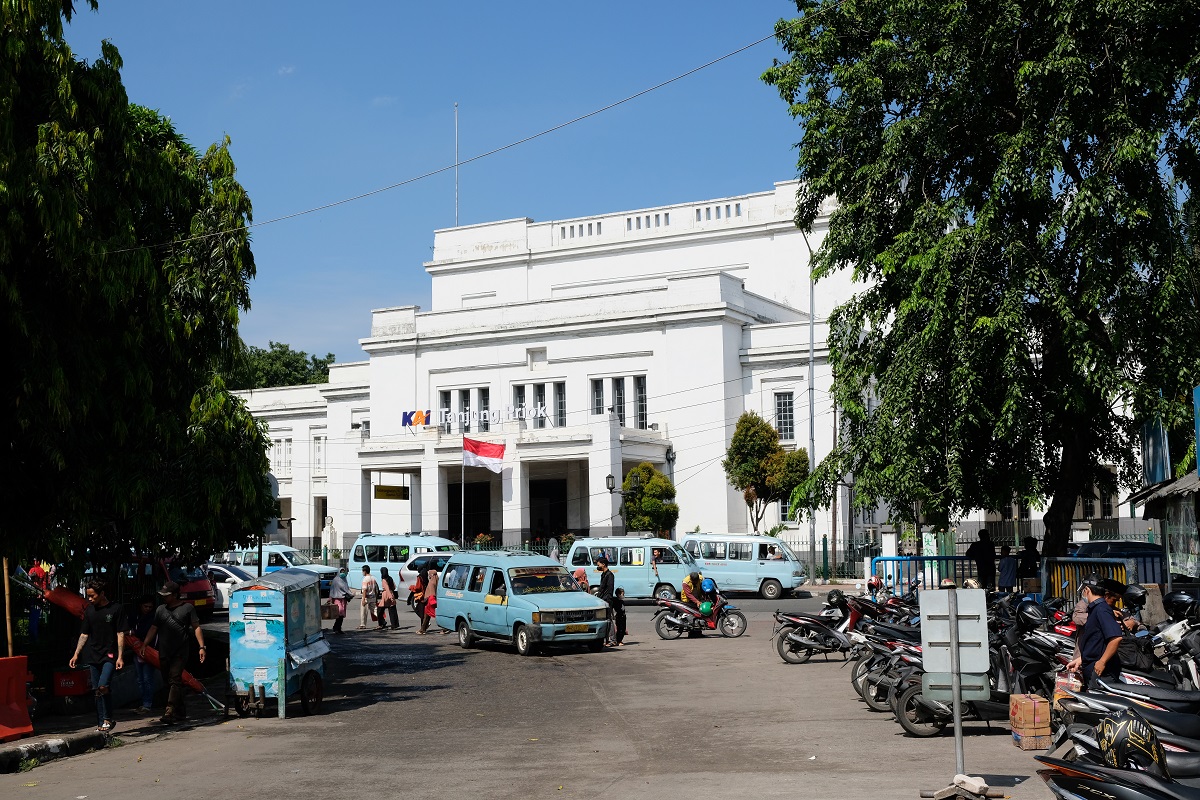




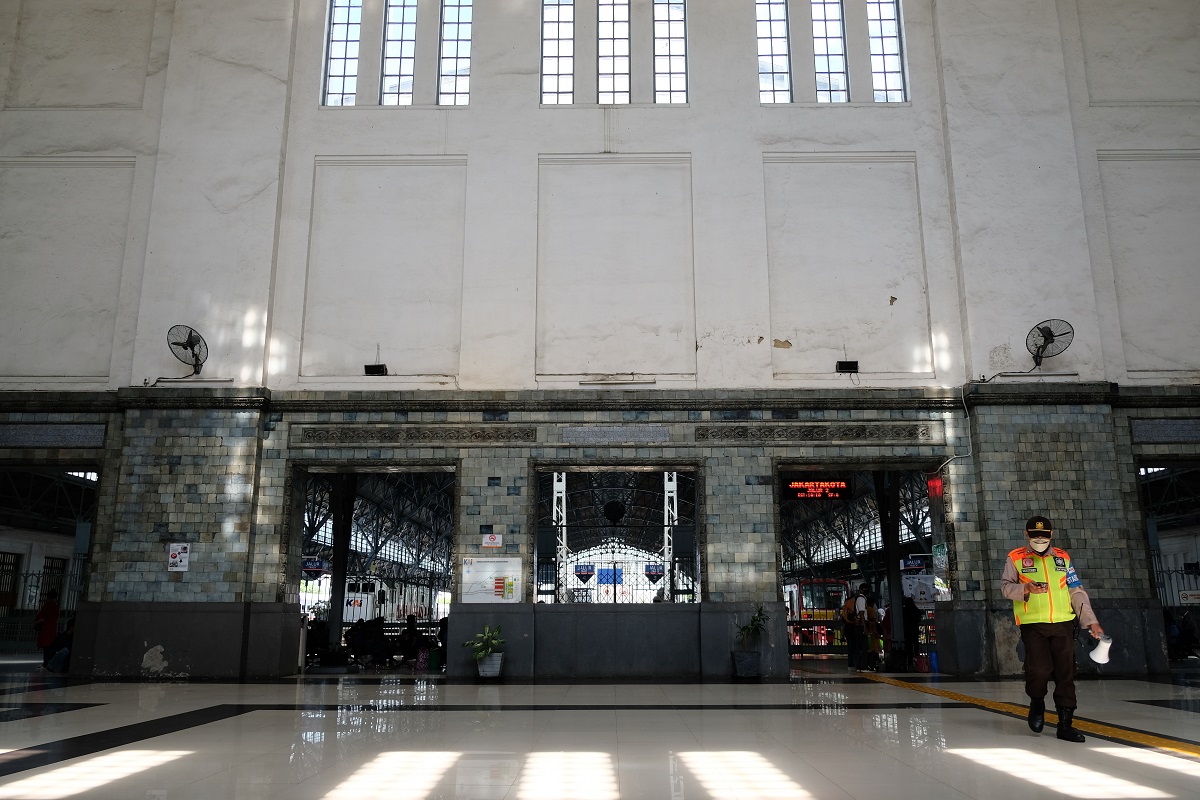



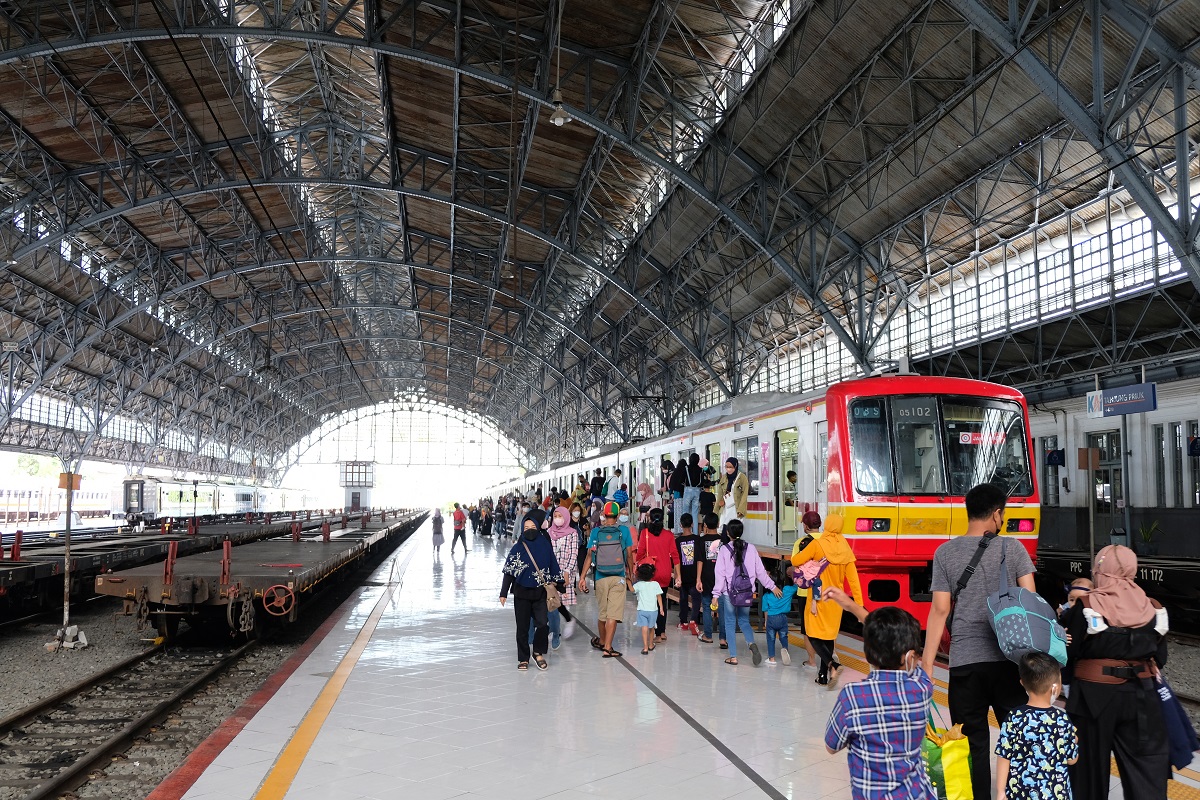





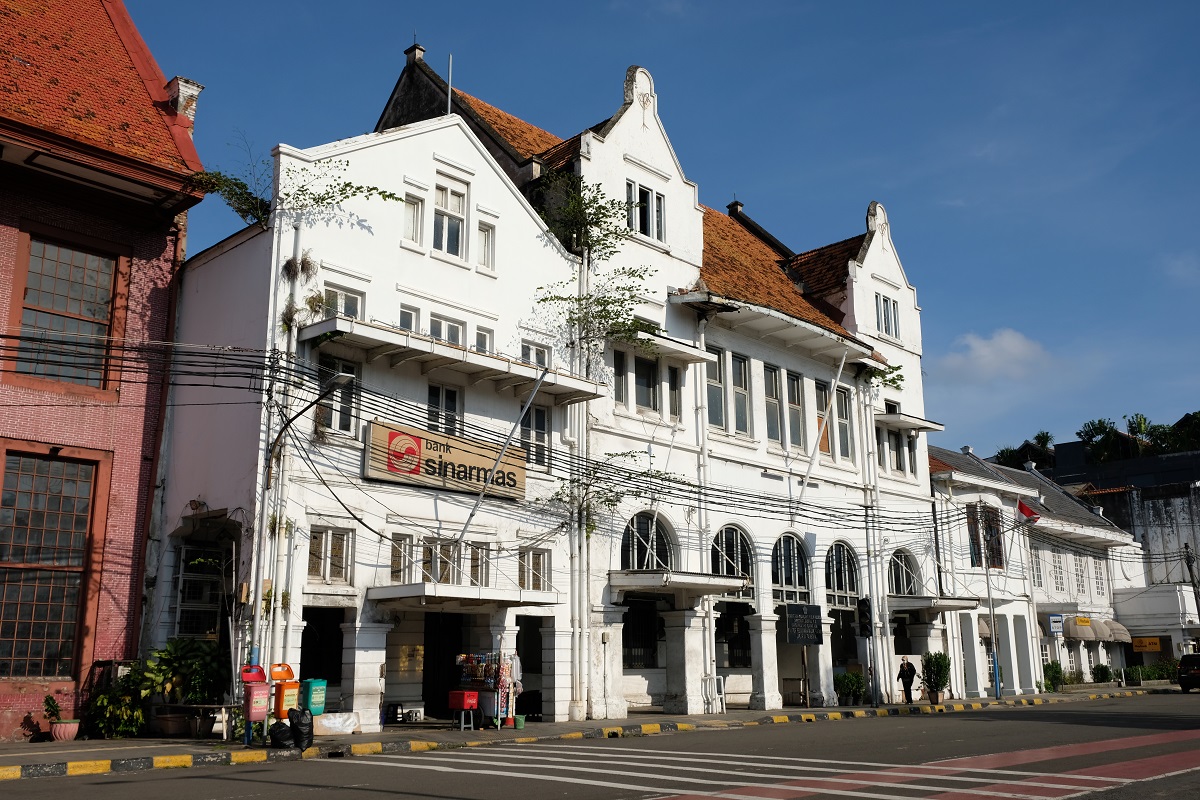
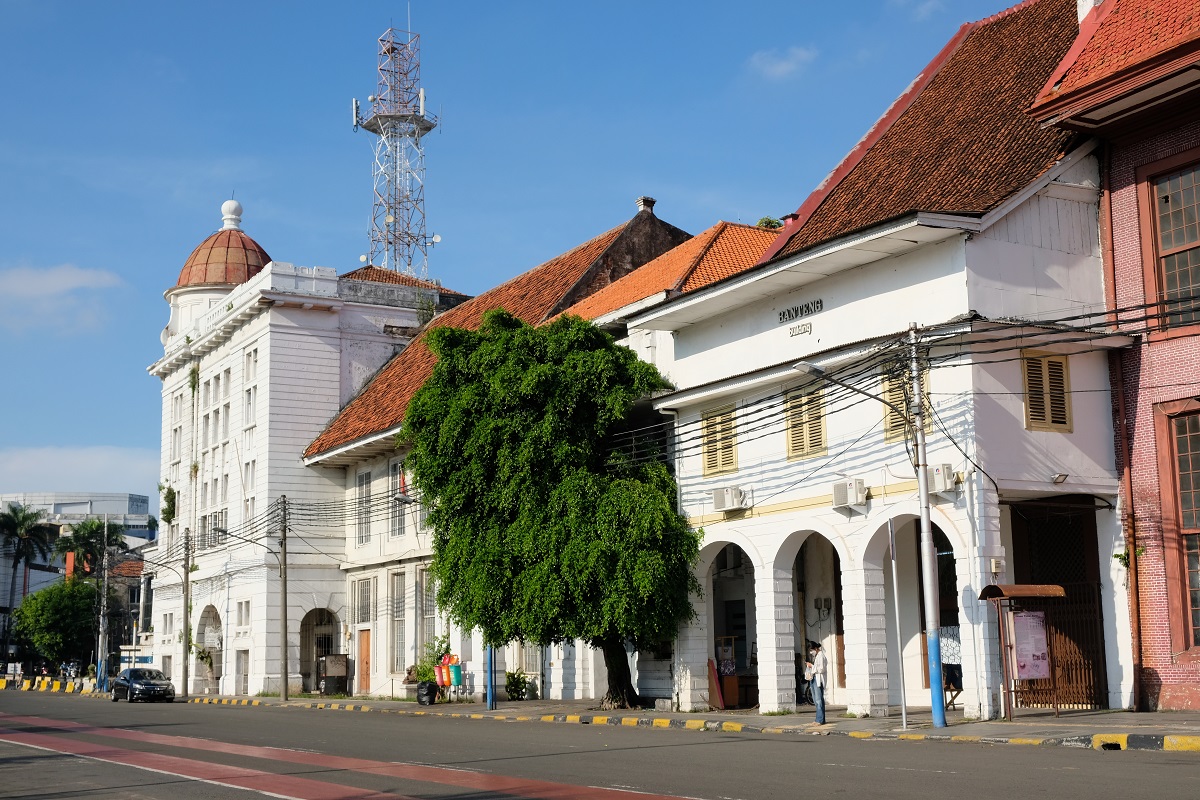

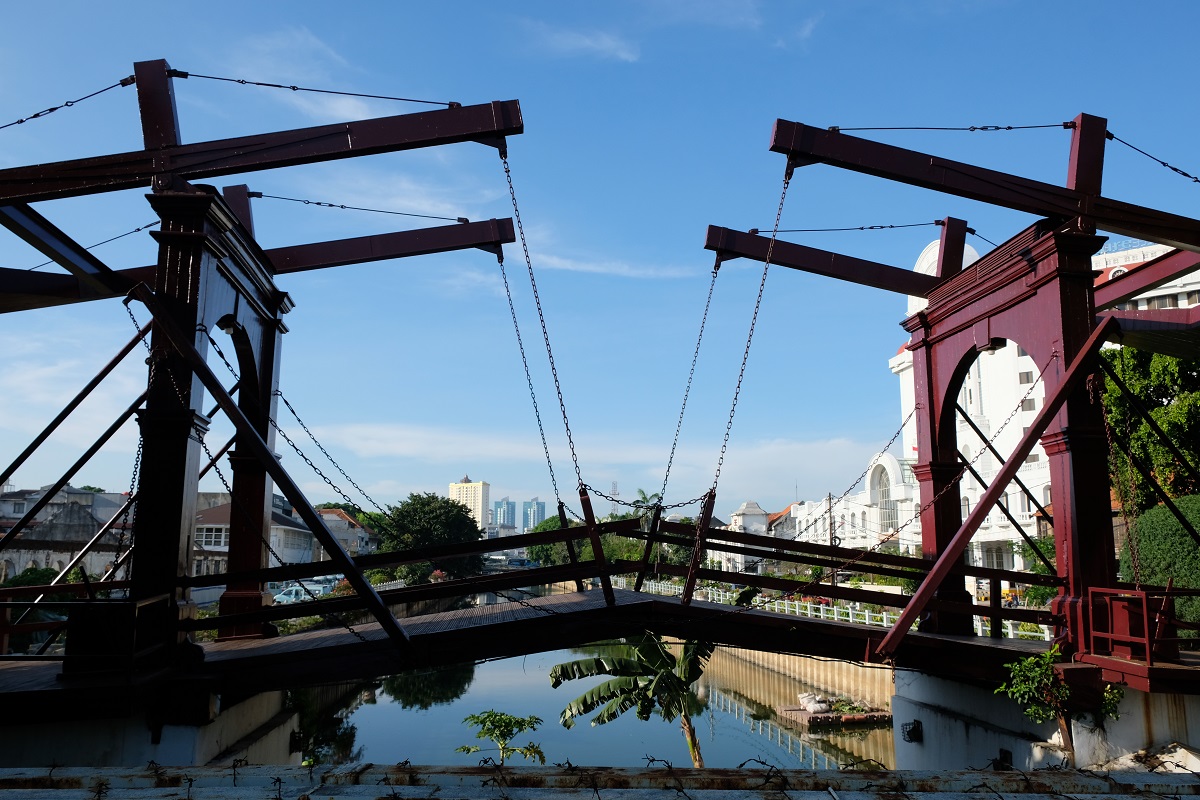
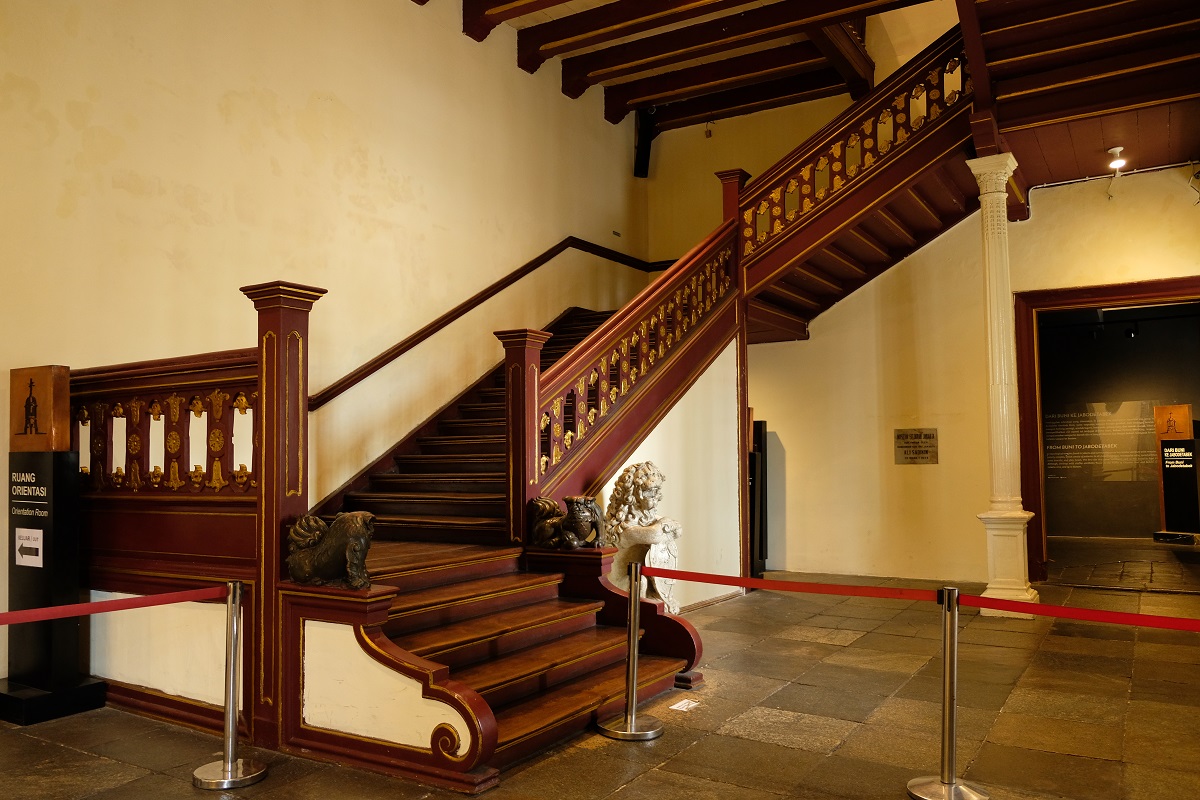


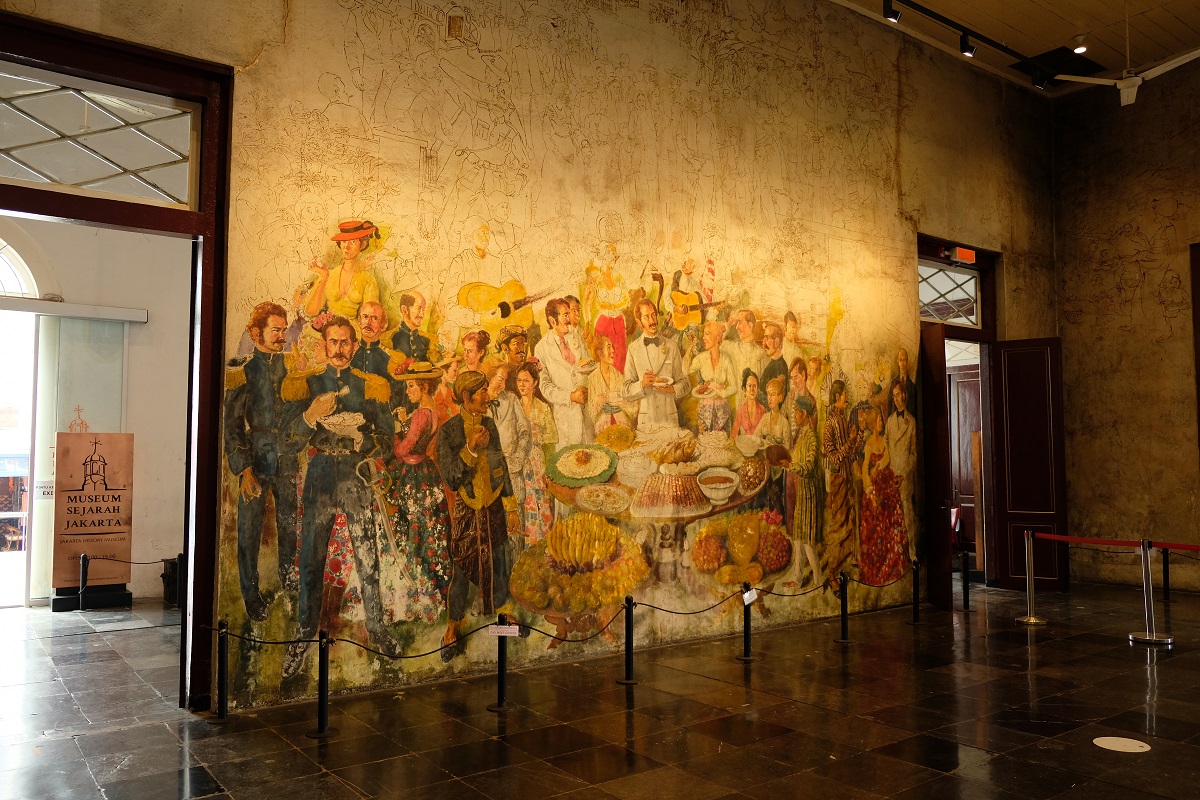

I love old railway stations. It is interesting that there their design is so standardized across the world. Not just the looks, but also that in most smaller old stations you can almost predict where things will be.
That bridge looks interesting. A double leaf bascule, or drawbridge isn’t it? It looks like it lifts to let boats pass under it.
LikeLiked by 1 person
I guess standardization made things a lot more efficient (it still does). For example, they only had to make one master design to be replicated multiple times with only minor adjustments here and there.
Yes, that is a drawbridge. Certainly an interesting remnant from Jakarta’s colonial past. Today, it’s mostly used as a photo background though.
LikeLiked by 1 person
True enough. Though I find it interesting that the English and the Dutch used the same design for train stations although they couldn’t agree on the track gauge for quite a while.
LikeLiked by 1 person
What’s interesting in Indonesia is while trains run on the same side with their counterparts in the Netherlands (and the rest of continental Europe), cars run on the same side with those in the UK (a vestige of the British brief rule in the archipelago in the 19th century).
LikeLiked by 1 person
I love the architecture of old train stations, and this looks to be a beautiful one. Train travel doesn’t really work that well in Canada either. It’s too big for it to make sense for passenger trains, but it’s widely used to transport goods. A few of our cities have lovely old train stations too. This looks like a ni e spontaneous trip for you! Maggie
LikeLiked by 1 person
I guess passenger trains are more appealing in places where distances between cities are relatively close, in a way that railways can still compete with air travel. And speaking of Canada, that reminds me of the train ticket I had booked with VIA Rail to go to Ottawa from Montreal back in 2020 which, as you can imagine, went up in smoke because of the pandemic.
LikeLike
I’ve ridden the train from Ottawa to Toronto and it was very comfortable and a great alternative. I imagine between Ottawa and Montreal is the same. They have a much larger population in that area to make passenger trains work. Hope you get to do it one day Bama. Maggie
LikeLiked by 1 person
I also have a fondness for trains and transit. They seem like such an efficient way to travel locally and go nearby cities, provinces and even countries, without the stress of traffic or the airport waits like you said.
It’s interesting to read about the historical intentions behind railway, which served economic purposes rather than the public transit side of things. A lot of trains on my part of the world are underground subways because of our four season year, and they take forever to construct and cause such disruption!
The historical sites you visited look so great. Old buildings were built to last and stand the test of time!
PS. Where’s the picture of your massive dimsum meal? 😆
LikeLiked by 1 person
To me, good transit systems are actually a cool way to explore a city. Not only can I go around relatively fast, but they also make me feel I’m a part of the solution to traffic problems.
Disruptions are inevitable when our cities are upgrading their transport infrastructure. But I must admit, I get frustrated too when such projects take too long to finish. There’s this new light-rail line near where I live that keeps being delayed! Fingers crossed next year it will finally be opened.
I guess I was too busy eating and thinking ‘how am I supposed to finish all this?’ I didn’t even take any photos with my phone. 😆
LikeLiked by 1 person
Yes, I agree with you that we should encourage more people to take transit where possible to help with congestion and also it’s better for environment. Good urban design creates these opportunities for sure.
You’ll have to share the light rail line update with us when it’s done!
LikeLiked by 1 person
I surely will!
LikeLiked by 1 person
What majestic train stations—far more tasteful than the ones here in the Lower Mainland. Still, I too like to use the local service know as the skytrain. If I wish to go downtown (Vancouver) there’s nothing better than watching the world go by from above ground, though most passengers are too drawn to their cell phones to notice.
LikeLiked by 1 person
That’s also one thing I always enjoy when taking the metro here in Jakarta, especially when the train goes above the ground. As for train stations, these two are among the loveliest that Jakarta has. Some of the more modern ones just look… basic.
LikeLiked by 1 person
Simple, practical design for a train station. Are there any shops nearby to buy food and coffee? We have a lot of them in Adelaide.
LikeLiked by 1 person
Absolutely! Convenience stores, cafes, and even fast food restaurants can be easily found at train stations here in Jakarta. It has become a necessity to have those businesses at these premises to cater to the needs of the urban dwellers.
LikeLike
You guys are lucky for having train stations from the colonial period still standing! Unfortunately, Manila has none of those colonial-era stations left in the current train system. The only one that stands, long defunct as a stop for trains, is under threat of demolition…
LikeLiked by 1 person
That’s unfortunate. I remember Manila has some really beautiful Spanish-era buildings, although I must admit I don’t have any recollections of how the train/LRT stations looked like — I mostly took the LRT to go around the city. Oh well, as long as they serve their purpose! 😀
LikeLiked by 1 person
I really enjoyed our little excursion out to Tanjung Priok and back – my favorite part of the grand old railway station there was the half-timbered signal box. It’s great the structure is well taken care of and still in such good condition after almost a century of use. Perhaps I am being too optimistic/unrealistic here, but wouldn’t it be wonderful if the entire station was spruced up and the area around it redesigned with inclusive mixed-use developments? Surely that would help drive up passenger numbers and make Tanjung Priok a more desirable place to live and work.
LikeLiked by 1 person
Oh that would be really cool, James! Although judging from how the station’s immediate surroundings look like, I’m sure it will take a really long time to make it happen. But maybe when the planned commuter train station near the new stadium is opened, this line will see a dramatic increase of passengers, and some of them may be interested in going a bit further to Tanjung Priok.
LikeLiked by 1 person
Like you, I love trains and train journeys. It is the second best mode of transport in my book, after walking. Old train station buildings are wonderful places to explore. I particularly love the tile work in this one and the cute, half-timbered structure. Also, that 17th century bridge which seems to be still functional is a real treasure. The UK offers some amazing scenic train rides, however, our train system is far from being reliable with frequent cancellations and delays.
LikeLiked by 1 person
Walking really is the best way to get to know a place better. You don’t have to spend money at all to do it, yet you get so much from doing it. It’s great that the train station in Tanjung Priok still retains much of its original look. To me it’s like a diamond in the rough — it has so much potential, and in the right hands it can be a really cool place. Speaking of train ride in the UK, my experience is limited to Eurostar which I took from Brussels. I’d love to try some of the scenic rides I’ve read about!
LikeLiked by 1 person
Totally agree, at some point I have to publish our experience riding the Jacobite Steam Train (better known as the Hogwarts Express) through northern Scotland.
LikeLiked by 1 person
Now that is one train ride I really want to try at least once in my life!
LikeLiked by 1 person
“Take a metro system, and you’ll be whisked to other parts of a city much faster than if you drive a car.”
…except in London where I can ride to work faster on a bike than on the Piccadilly Line!
Still, I do love an old train station. I loved Colombo’s central station, and the trains were an absolute gem. The one legacy of colonialism worth keeping, massively outweighed by the negative ones though.
I read somewhere that Java is getting its own Shinkansen, is that right?
LikeLiked by 1 person
Oh I remember taking the Piccadilly Line and thinking how crowded and cramped the Tube was compared to other metro systems in Europe. I can see why riding a bike is faster! There was a time when I biked to work, and I have to admit it was a very efficient way to get to the office and back.
Colombo Fort station certainly has quite a character. I love the architecture, and the old bridge connecting the platforms. Not all things colonial are bad. Unfortunately, in the early years of Indonesia’s independence, the country’s first president decided to dismantle many things Dutch, including a tram network which could have been a good public transport option for Jakartans.
Well, we were supposed to get a Shinkansen… until the government suddenly awarded the project to China — which unsurprisingly upset Japan. Many Indonesians, including me, think that the Japanese have more experience building high-speed rail network in seismically active regions, so they should be the ones doing this. And now the China-funded project keeps being delayed with cost overrun that only adds more burden to the national budget.
LikeLiked by 1 person
Yup, the Piccadilly Line is rubbish, but she’s in good company. The Central Line is positively horrendous, especially in summer, the Bakerloo is also rubbish and on the Northern Line they found noise levels unfit for humans. And then there’s the trains!
Yeah, buying Chinese feels ‘cheap’, but then often turns into a Faustian deal. Much of Central Asia have discovered that…
LikeLiked by 1 person
I don’t know if this is a good comparison or not, but based on my experience I still prefer Paris’ metro although it’s also very old with outdated stations still being used to serve millions of people every day.
There are now more and more evidence around the world about how China’s helping hands are not as good as how they may seem at first.
LikeLiked by 1 person
I love this post, Bama. It is so good to see that heritage buildings can still be functional in the present, while preserving the past. I would take a train instead of a plane any day. Of course depending on the distance I need to travel. Here in Portugal the train tracks are often built in very scenic stretches, which makes it far more enjoyable and relaxed than traveling on the highways by car or bus.
I didn’t realize that Jakarta is also sinking as sea levels are rising.
LikeLiked by 1 person
Glad you liked it, Jolandi. I think Indonesians are beginning to see the value of preserving old buildings as opposed to demolishing them. There have been a few exciting urban renewal projects in Jakarta alone which often involved “adaptive reuse”, turning what were once abandoned buildings into cool places to hang out with friends.
Speaking of train travel, I agree that distance makes all the difference. I won’t lie that I still prefer flying if I have to cover great distances. But train rides will always have a special place in my heart. When I go to Portugal one day, you know I’d love to take at least one of those scenic rides you mentioned.
Oh Jakarta is sinking… fast! I don’t know how more severe things will be ten years from now. But I hope the government take some serious actions to slow down the process.
LikeLike
You know, Bama, I can understand when people want to demolish colonial buildings, but no matter how one feels about that part of history, it is still a part of history, and like with life in general, if one can embrace the good with the bad, and adapt it, it can leave a much richer history behind. I like the term ‘adaptive reuse’, as these spaces are often very creative and hip, while retaining a snippet of history.
I certainly hope the Indonesian government is taking steps to prevent a crisis later. So often governments tend to wait until it is a big problem, and as Jakarta is such a populous city, it will affect so many people.
Oh, and remember to send me an email when you start planning your trip to Portugal. I would love to meet up with you somewhere – or you can always come spend a day or two here on the quinta! Maybe by then we have guest accommodation, and if not, there is a hotel nearby. 😁
LikeLiked by 1 person
Well said, Jolandi. I agree with every single thing you said about how we should deal with colonial buildings.
You’re so sweet! Thank you so much for the offer. I surely will drop you an email when a trip to Portugal is on the horizon. And it would be really cool to meet your in person. Of course I’d love to meet Midnight and Lily as well!
LikeLike
I couldn’t agree more about the benefits of travelling by train. It’s significantly less stressful and a great way to enjoy the scenery that you otherwise would have missed by flying or driving. I must say, Tanjung Priok looks like one of the cleanest train stations I’ve ever seen!
LikeLiked by 1 person
Tanjung Priok was indeed clean, which also surprised me to be honest. I hope the station will see more train services in the future because it certainly was built to serve a lot more passengers. Traveling by train must be one of the least stressful ways to go places, I believe. That’s why it always excites me when a new railway line is opened.
LikeLiked by 1 person
What a delight to have a virtual tour of these train stations. I had no idea Indonesia had such an extensive system of trains. when we visit Europe we marvel at the ease of train travel. Here in Calgary we have a train system but it is far from covering the entire city. In Canada generally, there are very few passenger trains connecting cities. those that do are very expensive.
LikeLiked by 1 person
I have to say, more than a decade ago, train services in Indonesia were at a far worse state that they are today. It’s quite remarkable to see how much they’ve improved. Have you taken the train in Japan? Of all countries I’ve been, it probably has the best railway systems — they’re on time, well-connected, and relatively easy to navigate. You can even plan your entire trip from point A to point B, through different train operators, down to the very minutes.
LikeLiked by 1 person
We have only had four days in Japan and agree the train system was incredible.
LikeLiked by 1 person
Nice to read about Indonesia’s rail history and see photos of the train station and colonial buildings. It’s interesting to see a 400-year-old bridge. I’m also a fan of trains and in SE Asia, I’ve taken them in Thailand, Malaysia, and Vietnam. Hope someday I can take a train in Indonesia. That said, the station, with its huge arched roof over the train boarding area, reminds me of those in Europe, especially the UK.
LikeLiked by 1 person
Train services in Indonesia are mostly concentrated on Java, the world’s most populous island. I think almost all train stations in this part of the world actually date back to the Dutch colonial era, and fortunately many of them are relatively well-maintained. I hope you’ll get to try it one day, Hilton!
LikeLiked by 1 person
I too love train journeys, though I’ve never taken a spontaneous one like you did with James. How thrilling! You’re inspiring to set out on one this very minute. Unfortunately train service in the US is not as easy as the rest of the world since we are very much an automobile-driven landscape. I still have incredibly fond memories of train trips taken in Peru, India, Russia and throughout Europe. Here’s to your next exciting train travel!
LikeLiked by 1 person
I’ve read countless articles about how car-centric US cities are, which is unfortunate. This can be changed, of course. I hope there will be more Americans like you who have traveled abroad and taken different train journeys, so when you’re back home you can help pique people’s interest in this means of transportation. Indian train trips will likely spark a different kind of discussion though!
LikeLiked by 1 person
Hahaha. Indian train trips are adventures for which I have to make sure I’ve packed my patience, my sense of humor, and lots of extra time!
LikeLiked by 1 person
Exactly! 😂 The network is extensive, but it requires everything you mentioned to enjoy it.
LikeLiked by 1 person
Don and I love trains too! They’re just about our favourite way to travel. I had no idea that there was such a great train network in Indonesia, I suppose because of there being so many islands. What a beautiful building Tanjung Priok is.
Alison
LikeLiked by 1 person
The government seems to begin to understand the importance of having an extensive railway network, not just for the economy, but also for the convenience of the people. That’s why we are seeing some previously closed train stations being reactivated across the island. Tanjung Priok station really was a marvelous work of art and engineering!
LikeLiked by 1 person
Lovely post Bama. You have a talent to write a post that is very interesting to read. I love trains, and I’d prefer travelling with them than airplane, for the reasons you have mentioned that you arrive in the city center with trains instead of far airport, and that you don’t go through the hassle of checking in and security in the airport.
However, as much as EU is trying to make train journey a more sustainable option, the price ticket for trains are still largely expensive or at least equal with airplanes, deterring people from taking the trains. I hope it would change in the future, and more comfortable night trains would be available.
LikeLiked by 1 person
Thank you, Eva. You’re too kind! Do you know why train tickets are expensive in Europe? This sounds counter-intuitive to me since Europe’s rail networks are quite well-connected compared to other parts of the world. Is it a result of the airline industry’s lobby? Or is it something else?
LikeLike
Honestly, I have no idea why the tickets are as expensive as airplanes, then again the salary level in EU in general are high although there is a perceptible difference between north and southern Europe, but I assume that the operating cost is probably nearly as high as the airplanes?
Then again most train companies are nationalised, so the only way forward is to give them a better state subsidy so they can press the price down? Who knows, one can only hope
LikeLiked by 1 person
That makes sense.
LikeLike
So do I, mas Bama! I love trains, specifically trains which are functioned as a transit system. Be it an MRT, LRT, monorail, or tram. In every city I visited, I always make my chance to ride its rail transit system. Like one of your friends said above, it is my way to blend with the locals and understand their culture.
That’s why I’m so glad that Jakarta has been improving these past few years. Finally, we have a descent metro system.
I’ve been to both Jakarta Kota and Tanjung Priok Station. Unlike you, for a transit system, I’d rather love the more modern type like the new Manggarai Railway Station. I like when I need to go up, or down, to reach my platform.
LikeLiked by 1 person
Trying the local rapid transit wherever I go is also one of the things I always do when I travel. There are so many interesting and exciting things about it — the different types of rolling stock, signage designs, announcement music and languages, etc.
I agree with you about Jakarta’s metro. I can’t wait for the LRT Jabodebek to finally open sometime next year. Fingers crossed Phase 2 of the MRT can be completed on time, and Phases 3 and 4 will be constructed soon.
LikeLike
I dearly hope the MRT Phase 2A could be finished as quick as possible, even faster than the scheduled date. I believe it would improve MRT Jakarta’s ridership as it connects Sarinah, Monas (so is Gambir Station), and the Old Town. It is a crucial extension for the tourism and travel industry of Jakarta.
LikeLiked by 1 person
I hope so. Although I also understand the higher level of difficulty of constructing the tunnel all the way to the old town district. Have you seen the rendering of the MRT station at Kota? I think it looks really cool and I can’t wait for the day when it becomes a reality!
LikeLike
Yes! All of those 4 new stations from Thamrin/Sarinah to Jakarta Kota. I really really have lots of agenda once I’m back to Jakarta 😂
LikeLiked by 1 person
I don’t know, I often find train travel in the UK can often be quite stressful, especially “post” covid with staff shortages and strikes. However, I find railway stations, no matter where they are, often have quite interesting architecture.
I’m glad you enjoyed your impromptu trip. Thanks for sharing it with us!
LikeLiked by 1 person
I read about the “post” Covid travel disruptions across Europe and they did look pretty bad, especially during the peak of the summer holiday season. I hope things have got better now. I agree with you about railway stations. The old ones are often very beautiful.
Thanks for reading, Nikki!
LikeLike
Fantastic post! I loved reading about the history of your country and city, it is so interesting! I also love travelling via train as it is much more convenient that plane in my opinion! Both stations actually look really nice and Tanjung Priok really looks kinda European, it’s crazy! Here too the areas around stations (regardless of their location in the city) are always a bit sketchy – i thought it was mostly a European thing ahah! Thanks for sharing!
LikeLiked by 1 person
Thanks Juliette! There will be more stories from Indonesia in the upcoming posts since I haven’t properly traveled abroad again since the start of the pandemic. Last month I actually flew again for the first time since December 2019, but it was for a business trip to Singapore, so that doesn’t really count. Fingers crossed in a few months’ time I’ll have my first real overseas holiday again! I have to say things have improved a lot in Indonesia in regards to railway services, including the areas around train stations. There are still a lot to improve, though.
LikeLike
I hope you get to travel soon too!!
LikeLiked by 1 person
Jakarta old town is seriously pretty! Our train system has gotten a lot better lately hope it continues to do so and not only in Java.
By the way, it’s been a while leaving a comment on your post, hope you are well Bama!
LikeLiked by 1 person
Hey Aggy! Likewise. It’s been a while indeed. I’ve been busy with work, but I’m not complaining. 😀 It’s very heartening to see how much rail transport in Indonesia has improved. And speaking of Jakarta, I’m now a regular user of the MRT, and I’ll be using the LRT Jabodebek a lot as well when it opens — hopefully next year.
LikeLiked by 1 person
I used to take the train on business trips and it was a lot more relaxing. I liked how you included a fair bit of history. I chuckled when I read how you suggested this trip after a massive dimsum lunch. I would have been in a food coma.
LikeLiked by 1 person
I know what you mean. In one of the previous companies I worked at, I often had to go out of town for business trips, and whenever possible I always opted for the train.
Ha! I remember I was sooo full I could barely walk.
LikeLike
You capture the mystery, history, and to me the most important possibility when viewing trains and railway lines and stations 🙂 Beautiful post and with your photography, it brings your words to life. I like your description of posing the question to James, “What about…” as this is what railway stations have to offer. Reminds me of walking in one of the old railways stations in Xi’an with a friend and bubbling with excitement knowing we could buy a ticket to Yunnan, Chengdu, Guangzhou… so many destinations right out in front of us. Beautiful writing, Bama. Well done! Again 🙂
LikeLiked by 1 person
As I was reading your kind words, I suddenly remembered the night train my mom and I used to take when I was little to visit her sister on school holidays. Indonesian trains back then were a lot less comfortable than they are today. So, in a way this post also acts as a reminder for me of how much things have improved.
Spontaneous trips can be fun, indeed. And I’m glad that morning I decided to bring my camera despite not knowing where to go after breakfast. When you were at that train station in Xi’an, did you end up going to one of those places?
LikeLike
What a fantastic post, Bama. Great photography. The stations look so clean and well-maintained. Beautiful art deco buildings. Train travel is just a sane way to go. Cheers!
LikeLiked by 1 person
Thanks John and Susan! Train stations in Jakarta today have improved a lot. I remember 15 years ago when I visited the city by train, I went to a toilet at a train station in the eastern part of Jakarta, and it was horrible. But now, things couldn’t have been more different.
LikeLike
I absolutely love travelling by train. It is such a romantic way to experience a new city or country and give you such a great sense of place- allowing you to really take in the landscape and your surroundings
LikeLiked by 1 person
Well said, Laura. I’ve heard about the Trans-Canada rail journey and I hope I’ll be able to try at least parts of it one day.
LikeLike
That would be such an epic adventure! I have done a cross-Canada road trip but not via rail- that would be spectacular- especially west in the Rocky Mountains.
LikeLiked by 1 person
Impressive iron frame! And the half-timbered structure looks interesting as well. Don’t you think it resembles a rail car? I intend to ask you about its function, but I found the answer in Jame’s comment. Would be great to see this signal box at work 🙂
If possible, I would choose trains over cars and airplanes. There are many reasons to enjoy a train trip: the scenery, the comfort, and sometimes the companion. Here, in Vietnam, the North-South railway is the most scenic route. They ran along the coastline most of the time. But unfortunately, it’s so outdated (dates back to the French period)… The train takes 1.5 days to travel from Hanoi to Saigon, while it only takes two hours by plane.
LikeLiked by 1 person
That’s an interesting comparison between that structure and a railcar! I can see why you think that way.
Actually when I was in Da Nang, I visited Hai Van Pass and saw a freight train running along the side of a hill. Does it run on the same railway with the passenger train you talked about? I can’t imagine doing the 1.5 days trip between Hanoi and Saigon.
LikeLiked by 1 person
Hai Van Pass is a perfect place to enjoy the view, Bama! How did you get there? By bike 🙂 Yes, it’s the main rail route in Vietnam. There are segments that run to Chinese border. But they are less scenic than the one that runs along the coastline.
LikeLiked by 1 person
There’s no way I could go to Hai Van Pass by bike! 😄 We rented a car and briefly stopped at this spot on our way from Da Nang to Hue.
LikeLike